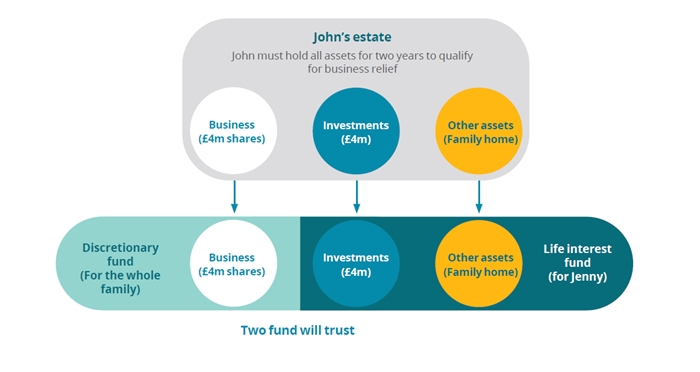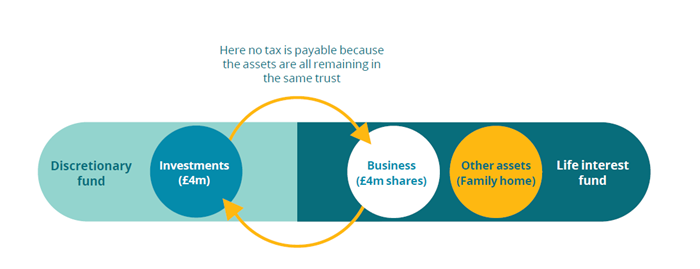Not only are there a number of pitfalls to be avoided, but proper planning can maximise the application of the valuable reliefs. We’ve set out an example of how well drafted wills can help to double the relief.
Business relief
Business relief (BR) is an extremely valuable relief and it’s, therefore, important to understand which assets qualify. After a person dies, inheritance tax (IHT) is charged at a rate of 40% on the value of assets exceeding the available nil rate band of the deceased person, unless an asset qualifies for business relief.
Business relief applies to interests in a trading business (100% relief) and assets owned personally but used in a business (50% relief), which have been held for more than two years. The relief is available provided that the business isn’t “wholly or mainly” an investment business or, put another way, it’s wholly or mainly a trading business. Viewed in the round, the trading side of the business must outweigh the investment side. A careful eye must be kept on assets held by the business, which aren’t actually used in the business, as these could result in relief being denied on the value of these excepted assets. Examples include properties used by the owner and their family, or large cash holdings that aren’t required for the operation of the business.
While it can be tempting for couples to rely on spouse exemption and simply leave everything, including their qualifying business assets, to the other on the first death, this strategy wastes a great tax planning opportunity that can result in benefitting from business relief on both the first and second deaths of a married couple. This potential for double relief is explained below.
Two fund will trusts – a case study
John is married to Jenny and has two children, a son from a previous marriage and a daughter with Jenny. John owns shares in a trading business which he runs with Jenny and their son. The shares are worth £4m, and an analysis confirms that they will benefit from business relief in full. In addition, John also has a portfolio of investments worth another £4m and owns the family home worth £2m.
John is keen to maximise the benefits of the inheritance tax relief but also ensure Jenny is provided for after his death. Eventually, he would like his two children to benefit equally from his estate.
We advise John to put in place a “two fund will trust” in order to achieve these aims. His will would pass his assets that qualify for business relief (that is, his shares in the business) into a fund of the trust which would be fully discretionary. His personal representatives can claim relief on the shares and hold these on flexible trusts for the benefit of Jenny and his children. John’s remaining assets would pass into a fund in which Jenny had a life interest, so that spouse exemption could be claimed. As “life tenant”, Jenny would be entitled to all the income arising from the assets in the life interest trust, as well as the right to remain living in their home. Jenny would also be a beneficiary of the discretionary fund of the shares.

A key part of this planning is that the relievable and non-relievable assets are held within two funds of the same trust. This means, if appropriate to do so, the trustees can choose to exchange assets of equivalent value between the funds, without incurring a capital gains tax or stamp duty land tax liability. If these assets were ‘swapped’, the shares would subsequently be held on life interest trusts, and the investments would be held on discretionary trusts.
Assuming Jenny survives for two years, the shares will again qualify for business relief. The shares can either be held in the fund until her death and business relief claimed at that time, or she can choose to make a gift of the shares. This gift would be free of tax if she survived seven years from the gift, or, if she died sooner, the shares would still receive relief at that time. Regardless of whether the shares are gifted or retained, there would be a £1.6m in inheritance tax saved compared to Jenny’s fund holding non relievable investments.
There would be no charge on Jenny’s death on the investments, as these will be subject to the trust relevant property charging regime, essentially meaning there is a maximum tax charge of 0.6% for every year the investments stay in trust. This means that every ten years the total savings are reduced by £240k.
After Jenny’s death, the trustees may choose to keep the assets in the trust, or distribute them to the children or grandchildren, in accordance with John’s wishes. There’s flexibility as to how this is done, for example the children can benefit from an equal share in each asset, or business assets could go to one child, and investment to another.

Conclusion
There are a number of options available to the trustees along the way, as flexibility is built into the structure at every step. This means the trustees can take whatever action is in the best interests of the family at the time, be that maximising tax savings, asset protection or something else. The trustees can decide to wind up the trust if the planning is no longer appropriate, or not needed at the time. This means that including this sort of planning into a will can ensure the trustees are in the best position possible.
For guidance on managing your business, read our latest owner managed business special edition of Private Affairs.
Our content explained
Every piece of content we create is correct on the date it’s published but please don’t rely on it as legal advice. If you’d like to speak to us about your own legal requirements, please contact one of our expert lawyers.